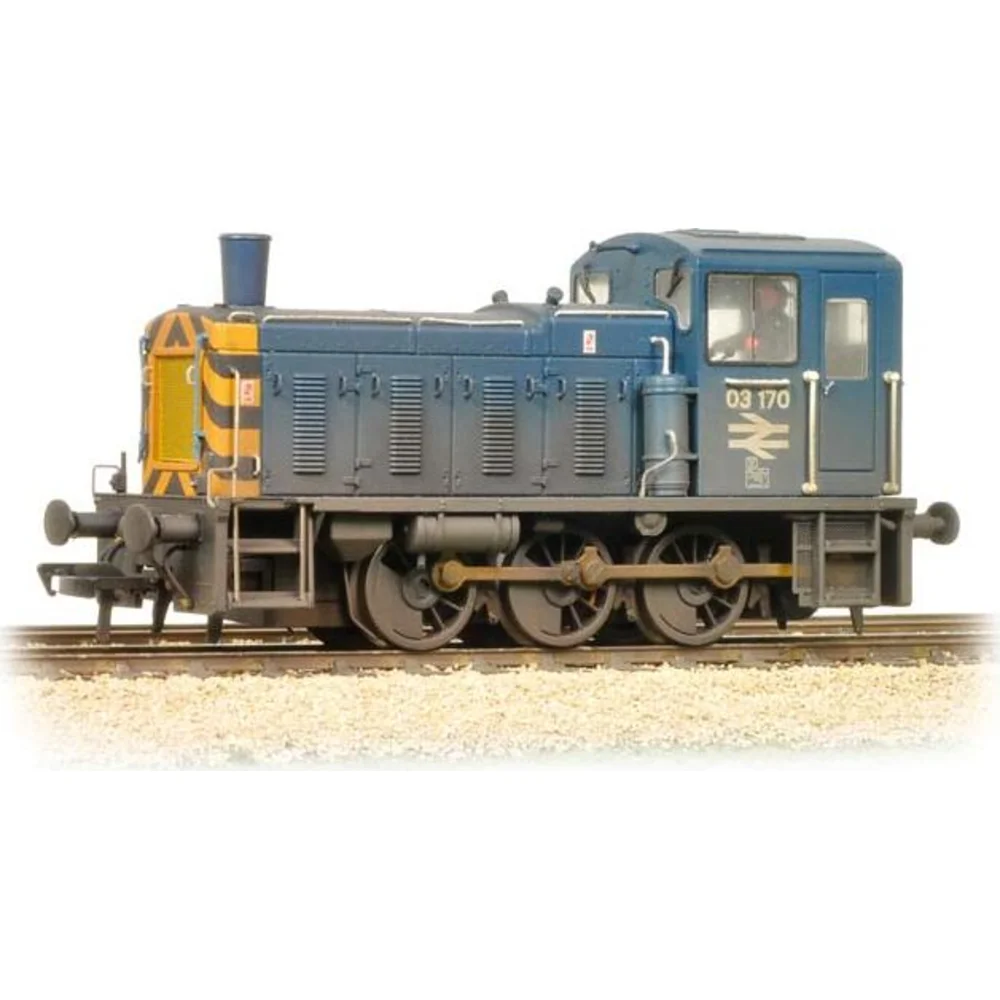Bachmann 31-365
British Rail Class 03 03170 British Rail Blue
Tooling
In 2010, Bachmann introduced an upgraded Branchline tooling for their OO gauge British Rail Class 03 shunter. This marked a significant evolution over the late 1990s ex-Mainline tooling, bringing coreless motors, enhanced detailing, and DCC-ready features to a model that had enjoyed great popularity. The upgrade bridged the gap between traditional analogue operation and modern digital flexibility, while maintaining scale fidelity and value.
Tooling Features
- Scale: OO gauge (1:76), first-radius curves (371 mm) capable.
- Construction: High-fidelity plastic bodyshell with separately-fitted items — handrails, chimney, roof-mounted horn, lamps, and windshield wipers. Chassis is die-cast with integrated split-frame design.
- Detailing: Engine cab interior complete with seated driver, glazing, underframe pipework, sandboxes, buffer beams, and accurate jackshaft mechanism visible from the chassis.
- Couplings: Fitted with NEM pockets. Standard tension-lock couplings removable in favour of deep buffer beam plates and scale couplings.
Mechanical & Electrical
- Motor & Drive: Installed with a coreless motor for more reliable low-speed performance; traditional jackshaft drive retained.
- Pickups & Wheels: Pickups on both wheels of each axle ensure good traction; all wheels driven and die-cast chassis provides essential weight.
- Minimum Radius: Handles first-radius curves (371 mm) with ease.
- Lighting: DCC operation supports cab lighting; analogue models remain without built-in lighting.
- Weighting: Heavier chassis delivers consistent traction and hauling capacity.
DCC Capability
- Comes factory-equipped with a 6-pin decoder socket, ready for DCC installation.
- Versions included "DCC Ready" format; a “sound-fitted” variant with factory-installed ZIMO decoder and speaker is available.
- Optional speaker space allows retrofitting of third-party sound and stay-alive decoders.
Liveries Produced
The 2010 tooling was offered across a range of authentic liveries, including:
- BR green with late crest (1957–1972)
- BR blue “wasp stripes” (1965–1990)
- Network Southeast (1986–1994)
- WAGN (1997–2006)
- British Army/MoD variations
Reviews & Commentary
- Reviewers consistently praised the smooth, quiet operation courtesy of the coreless motor and enhanced gearbox tolerance.
- Detailing was applauded — notably flush glazing, separate handrails, and precise paint finishes.
- Some users flagged occasional mechanical noise in early batches, usually remedied via lubrication and running in.
Media & Social Media Insights
- YouTube “unboxing & review” videos highlight improved mechanical smoothness, DCC readiness, lighting, and overall visual fidelity.
- Forum discussions on RMweb and similar sites focus on the ease of fitting decoders and sound upgrades, and note strong performance on compact layouts thanks to first-radius capability.
- Owners often report that the factory-fitted sound variant delivers excellent audio realism combined with reliable mechanical performance.
Other Interesting Information
- Accessory packs include buffer beam plates and scale coupling kits to replace tension locks.
- A recommended 30–60 minute running-in on moderate speed helps smooth gearbox and drive components.
- Placing a stay-alive device (e.g., capacitor pack) inside the cab improves power pickup and stall resistance during shunting.
- The tooling remains a popular choice for small, realistic shunting layouts and has set a standard for later Bachmann diesel retooling.
Class & Prototype
- Class: British Rail Class 03
- Traction: Diesel
- Transmission: Mechanical
- Built: 1957-1961
- Total Built: 230
The BR Class 03 was British Railways' standard light diesel-mechanical shunter, with 230 built at Doncaster and Swindon Works between 1957-1962. Powered by the legendary Gardner 8L3 engine and featuring distinctive jackshaft drive with coupling rods, these 30-ton locomotives excelled on weight-restricted lines, docks, and industrial sidings where heavier Class 08s couldn't operate. Notable variants included nine cut-down cab examples for the Burry Port & Gwendraeth Valley Railway and two for Isle of Wight tunnel clearance. With 56 preserved (24% survival rate) and the last example working until 2008, the Class 03 remains popular with heritage railways and modellers alike.
No prototype found.
Operator & Livery
- Operator: British Rail
- Livery: Blue
British Rail (1965-1997) transformed Britain's railways through revolutionary modernisation, introducing the iconic double arrow logo, Rail Blue livery, and business sectorisation. BR pioneered high-speed rail with the InterCity 125 and Advanced Passenger Train, electrified major routes, and created profitable divisions like InterCity and Network SouthEast. From steam succession through diesel and electric development to privatisation preparation, British Rail's diverse locomotive fleet, multiple livery schemes, and operational scenarios provide unparalleled variety for railway modellers across all scales and periods.
BR Blue, also known as Rail Blue or Monastral Blue, was introduced in 1965 as part of British Rail's comprehensive corporate identity overhaul that accompanied the rebranding from British Railways to British Rail. The colour was officially defined by British Standards BR28/6001 (airless spray finish) and BR28/5321 (brush finish), representing a dark, greyish blue tone specifically chosen to hide dirt and weathering effects well.
The livery was prototyped on the experimental XP64 train in 1964 before becoming the standard scheme from 1 January 1965. Rail Blue was applied to all diesel and electric locomotives with yellow warning panels (initially small, then extending to full yellow ends from 1966). The standardised application included the iconic double arrow logo and Rail Alphabet typeface, creating one of the most successful transport corporate identities of the 20th century.
The livery dominated British Rail operations for over two decades until sectorisation in the 1980s began fragmenting the unified appearance. Despite initial colour fading problems in early applications, these were resolved by the late 1970s when the Large Logo variant was introduced featuring extended yellow areas and full-height double arrow symbols. Rail Blue's enduring appeal among railway enthusiasts reflects its role as the definitive British Rail image during the organisation's most unified period.
